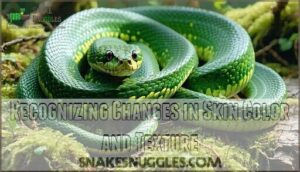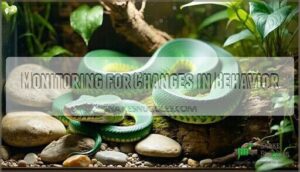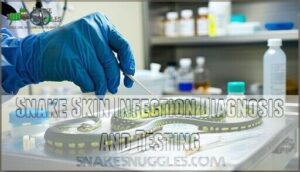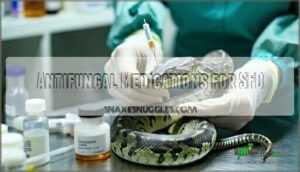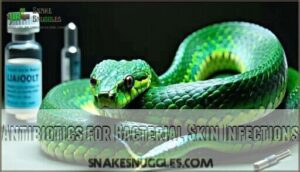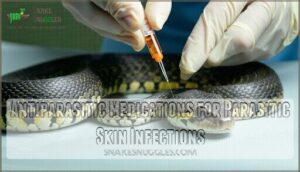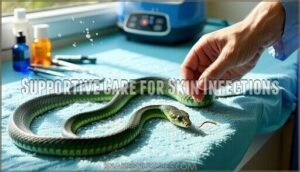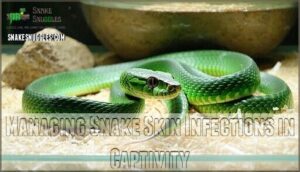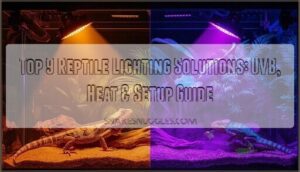This site is supported by our readers. We may earn a commission, at no cost to you, if you purchase through links.

Keep that enclosure spotless—dirty substrate is like rolling out the red carpet for bacteria and fungi.
Maintain humidity between 50-80% depending on your species, because dry skin cracks and becomes infection central.
Feed quality prey and avoid overhandling, which stresses your snake’s immune system.
Think of it as snake skincare 101: moisture, cleanliness, and TLC go a long way.
Your slithery friend’s skin tells a story about their overall health.
Table Of Contents
- Key Takeaways
- Snake Skin Health Basics
- Common Snake Skin Infections
- Preventing Snake Skin Infections
- Snake Fungal Disease (SFD) Prevention
- Identifying Snake Skin Infection Symptoms
- Snake Skin Infection Diagnosis and Testing
- Treatment Options for Snake Skin Infections
- Managing Snake Skin Infections in Captivity
- Impact of Snake Skin Infections on Conservation
- Best Practices for Snake Owners
- Frequently Asked Questions (FAQs)
- How to prevent snake fungal disease?
- What to do if a snake has an abscess?
- What happens if you don’t treat a snake’s wound?
- Do snakes have dermatitis?
- How do snakes survive a snake infection?
- How do you get rid of a herp infection in a snake?
- How to protect snake skin?
- What does a skin infection look like on a snake?
- What is the antibacterial ointment for snakes?
- How do parasites contribute to skin infections?
- Conclusion
Key Takeaways
- Maintain the "holy trinity" of snake care: Keep your enclosure spotless with weekly cleaning, maintain proper humidity (50-80% depending on species), and provide quality nutrition to strengthen your snake’s immune system.
- Monitor your snake’s skin regularly: Watch for color changes, unusual texture, lesions, or behavioral shifts like lethargy or appetite loss – early detection prevents minor issues from becoming serious infections.
- Create a stress-free environment: Provide secure hiding spots, maintain consistent temperature gradients (75-95°F), ensure proper ventilation, and minimize handling to keep your snake’s immune defenses strong.
- Seek professional help when needed: Don’t wait if you notice concerning symptoms – consult a reptile veterinarian immediately for proper diagnosis and treatment of any suspected skin infections.
Snake Skin Health Basics
Your snake’s skin health depends on getting the basics right from day one.
When you understand what affects their skin – from humidity levels to nutrition – you’re setting up your scaly friend for a lifetime of healthy sheds and infection-free living.
Factors Affecting Skin Health
Three major factors affect your snake’s skin health and can lead to snake skin infection if ignored.
Enclosure Microclimates create the foundation—wrong humidity or temperature stresses your pet’s immune system.
Nutritional Deficiencies weaken skin integrity, making infections likely.
Genetic Predisposition means some snakes naturally face Shedding Difficulties or reptile skin health issues.
Smart environmental factors management and proper snake skin care prevent most problems through consistent Injury Prevention practices.
Importance of Proper Hydration
Hydration balance makes the difference between healthy sheds and stuck skin that invites snake skin infection.
You’ll want to provide fresh drinking water access in a sturdy bowl while avoiding soggy substrates.
Water quality matters—change it weekly to prevent bacterial growth.
Watch for dehydration symptoms like wrinkled skin or poor appetite.
Proper humidity prevents shedding and hydration problems, keeping your snake’s skin supple and infection-free.
Role of Nutrition in Skin Health
Proper nutrition acts as your snake’s armor against skin infections. Just like you need your daily vitamins, snakes require balanced nutrition to maintain healthy skin and strong immune systems.
Key nutritional factors for healthy snake skin:
- Dietary deficiencies in vitamins A and E weaken skin integrity and healing
- Supplementation strategies should target calcium, vitamin D3, and essential fatty acids
- Gut microbiome health directly impacts nutrient absorption and immune function
Obesity impact shouldn’t be overlooked either—overweight snakes face increased infection risks.
Environmental Factors Impacting Skin
Your snake’s environment acts like a second skin—it can make or break their health.
Poor environment conditions create perfect breeding grounds for infections, while proper temperature control, humidity, ventilation, and substrate keep your scaly friend thriving.
- Enclosure Microclimates: Monitor temperature gradients and avoid drafts that stress snakes
- Substrate Hygiene: Choose materials that support natural behaviors while preventing contamination
- Hydration Management: Provide clean water without creating chronically wet conditions
- Injury Prevention: Remove sharp objects that could create pathogen entry points
Common Snake Skin Infections
When your snake’s skin starts showing troubling signs, you’re likely dealing with one of four main infection types that can seriously impact their health.
Understanding bacterial, fungal, parasitic, and viral skin infections helps you spot problems early and take action before they become dangerous complications.
Bacterial Skin Infections in Snakes
Bacterial infections hit when your snake’s environment gets messy.
These opportunistic bugs like Aeromonas and Pseudomonas love dirty bedding and poor hygiene. You’ll spot red, inflamed skin with blisters that can turn into nasty ulcers.
Prevention means keeping things clean, maintaining proper temps, and catching symptoms early. Quick diagnosis and treatment with antibiotics save the day!
Retained skin can also cause issues, leading to bacterial skin infections.
Fungal Skin Infections in Snakes
Beyond bacterial troubles, fungal infections present another serious threat to your snake’s wellbeing. Snake Fungal Disease (SFD), caused by Ophidiomyces ophiodiicola, can devastate both wild and captive populations.
This sneaky fungus thrives in soil and spreads through direct contact or contaminated surfaces.
Here’s what makes fungal skin infections particularly concerning:
- Silent spread – your snake might carry the fungus without showing symptoms
- Facial deformities – swelling and nodules can permanently disfigure your pet
- Deep tissue invasion – advanced cases reach muscles, bones, and organs
- High mortality rates – up to 40% of infected snakes don’t survive
- Conservation crisis – SFD threatens entire wild snake populations
Antifungal medications like terbinafine offer hope for SFD Treatment, but Fungal Diagnosis requires professional lab testing.
Infection Control through proper Captive Prevention protects your snake while reducing Wild Impact on native populations.
The disease is characterized by noticeable facial swelling in affected snakes.
Parasitic Skin Infections in Snakes
Mite infestations are your snake’s biggest nightmare among parasitic infections.
Ophionyssus mites spread like wildfire in dirty enclosures, causing anemia and crusty skin.
You’ll spot these tiny vampires crawling around or see your snake soaking excessively.
Prevention strategies include quarantining new snakes and maintaining spotless habitats.
Deworming protocols handle internal parasites, while tick removal requires careful extraction to avoid leaving mouthparts behind.
Viral Skin Infections in Snakes
Unlike other snake skin infections that you can see coming, viral infections like IBD can be sneaky troublemakers.
IBD transmission happens through direct contact and contaminated equipment, while paramyxovirus symptoms include ulcerative dermatitis alongside respiratory issues.
These viral diagnostics require lab testing since they’re masters of disguise, and implementing strict quarantine protocols prevents these retrovirus impacts from spreading through your collection.
Preventing Snake Skin Infections
You don’t want your snake turning into a scaly drama queen with itchy, infected skin, so let’s talk about keeping things clean and comfy.
If you nail enclosure cleaning, humidity, temperature, and diet, your snake’s skin will stay smoother than a fresh shed.
Proper Enclosure Cleaning and Disinfection
Keep your snake’s enclosure spotless with weekly cleaning and bi-weekly disinfection protocols.
Remove waste daily, sterilize tools between uses, and choose appropriate substrate for easy maintenance.
Use safe disinfectants that won’t harm your snake, ensuring proper ventilation systems during cleaning.
Regular enclosure sterilization prevents bacterial growth, while smart substrate selection makes waste removal a breeze. You can find a suitable cleaner online for this purpose.
Material Inspection
Reducing Stress and Promoting Relaxation
Creating a stress-free sanctuary is your snake’s secret weapon against skin infections.
Stress weakens immune defenses, making your scaly friend vulnerable to bacterial and fungal invaders. Think of stress management as building an invisible shield around your pet.
- Secure Hiding spots that mimic natural rock crevices or hollow logs
- Enclosure Enrichment like branches and fake plants for exploration
- Consistent Routine during feeding and gentle handling techniques
Environmental stress from loud noises or sudden movements can trigger skin problems, so maintaining a relaxation haven keeps infections at bay.
Providing a Balanced Diet
Balanced diet forms your snake’s foundation for healthy skin.
You’ll want to provide proper nutrition through appropriate prey variety – rotating between different feeder types guarantees complete vitamins and minerals.
Consistent feeding schedules prevent stress-related skin issues.
Watch for nutrient deficiencies that weaken immunity, and consider dietary supplements only when recommended by your vet.
Obesity prevention matters too – overweight snakes struggle with shedding and develop skin problems.
Maintaining Proper Humidity and Temperature
Getting the humidity and temperature just right keeps your snake’s skin healthy and prevents infections. Think of it like setting up the perfect sauna – not too steamy, not too dry.
- Maintain 50-60% humidity for most species to support proper shedding and prevent scale rot
- Create temperature gradients with a warm basking spot (85-95°F) and cooler area (75-80°F)
- Use reliable hygrometers and thermometers to monitor enclosure microclimates accurately
- Ensure proper ventilation to prevent stagnant air and excessive moisture buildup
- Avoid direct sunlight and drafts that can destabilize temperature and create environmental stressors
To accurately measure humidity, consider using a snake enclosure hygrometer.
Snake Fungal Disease (SFD) Prevention
Snake Fungal Disease (SFD) is one of the most serious threats your snake can face, and it spreads faster than gossip in a small town.
You’ll want to understand how this nasty infection moves between snakes and what you can do to slam the door on it before it becomes a problem.
Understanding SFD Transmission
Snake Fungal Disease (SFD) spreads through direct contact between snakes and environmental contamination from infected soil or surfaces.
Asymptomatic carriers can unknowingly transmit the disease, making detection tricky.
While SFD shows no zoonotic potential for humans, people act as transmission vectors when moving contaminated equipment between habitats, spreading snake skin infections unintentionally.
Diagnosis often requires laboratory confirmation due to subtle symptoms.
Minimizing Outdoor Equipment Contamination
Equipment cleaning isn’t just housekeeping—it’s your first line of defense against spreading Snake Fungal Disease between sites.
Proper equipment sterilization and cleaning protocols protect both wild and captive snake populations from this devastating pathogen.
- Hot water decontamination at 122°F for 30 minutes kills SFD pathogens effectively
- Physical scrubbing with stiff brushes removes organic material before disinfectants work
- Dedicated field tools for specific sites prevent cross-contamination between habitats
- Separate storage keeps contaminated and clean equipment apart during transport
- Thorough drying at proper temperatures adds secondary pathogen elimination
Educating The Public on SFD Prevention
Through community outreach, you’re building a powerful defense against Snake Fungal Disease SFD.
Public education programs spread SFD awareness through fact sheets, workshops, and social media campaigns.
Teaching proper hygiene protocols and biosecurity measures helps prevent disease transmission.
When you promote responsible ownership and conservation impact awareness, you’re protecting both captive and wild snake populations from this devastating infection.
Importance of Continued Research and Monitoring
Research keeps us one step ahead of Snake Fungal Disease SFD and emerging pathogens.
Scientists track SFD advancements and resistance patterns to improve treatment efficacy.
This ongoing disease monitoring helps identify new environmental factors affecting snake health.
Better prevention strategies mean healthier snakes and reduced conservation impact—plus you’ll sleep better knowing your scaly buddy’s protected!
Identifying Snake Skin Infection Symptoms
Early detection can save your snake‘s life, so you’ll want to watch for subtle changes that might signal trouble brewing.
Catching skin infections before they spread means knowing what normal looks like for your specific snake and spotting when something’s off, which is crucial for early detection.
Recognizing Changes in Skin Color and Texture
Your snake’s skin tells a story, and learning to read it can save its life.
Healthy scales should be vibrant and smooth, while snake skin infection often shows through obvious warning signs.
Here’s what screams "help me" from your scaly friend:
- Scale discoloration – patches that look off-color or faded
- Texture irregularities – rough, bumpy, or unusually soft spots
- Shedding abnormalities – stuck shed or patchy molting
- Blister identification – fluid-filled bumps under scales
- Skin lesions – any open wounds or suspicious marks
Watch for these reptile skin problems during regular handling sessions.
Identifying Lesions, Nodules, and Ulcers
Beyond skin discoloration, you’ll want to watch for raised bumps, open sores, or unusual growths. These physical changes often signal bacterial infection or fungal infections requiring immediate attention.
| Finding | What It Looks Like | Your Next Move |
|---|---|---|
| Small bumps (nodules) | Raised, firm lumps under discolored scales | Schedule vet visit within days |
| Open sores (ulcers) | Raw, weeping wounds on skin surface | Emergency vet care needed |
| Crusty patches (lesions) | Scabbed or flaky areas with inflammation | Begin daily visual inspection routine |
| Swollen areas | Puffy, enlarged sections of body | Document size/location, call vet |
Early detection through regular visual inspection saves your snake from serious complications. Check weekly during handling sessions, focusing on the belly and areas prone to moisture buildup.
Monitoring for Changes in Behavior
Behavior changes often reveal what physical symptoms might miss. Your snake’s daily habits can shift when skin issues develop, giving you early warning signs.
When your snake acts differently, pay attention to these key changes:
- Appetite changes – refusing food or eating less frequently
- Activity levels – becoming lethargic or unusually restless
- Shedding frequency – irregular or incomplete sheds
- Hiding behavior – spending more time concealed than normal
Watch for these emotional indicators:
- Your snake seems "off" or withdrawn – trust your gut instincts about personality changes
- Increased defensive behavior – hissing, striking, or avoiding handling more than usual
These behavioral snake symptoms often appear before visible lesions. Regular snake health checkups help you establish your pet’s normal patterns, making changes easier to spot.
Detecting Unusual Odors or Discharges
Your nose knows trouble when infection odor signs hit. Foul smells from your snake’s enclosure often signal snake skin bacteria or bacterial infections.
Watch for discharge types like nasal or eye secretions—these snake symptoms need early detection. Don’t ignore shedding problems either.
Preventative measures include regular cleaning, but persistent odors demand veterinary consultation to stop snake skin infection before it spreads.
Snake Skin Infection Diagnosis and Testing
When your snake shows signs of skin trouble, proper diagnosis becomes your best friend for getting them back to perfect health.
Your vet will use laboratory tests, imaging techniques, and thorough examinations to pinpoint exactly what’s bugging your scaly buddy and create the right treatment plan.
Laboratory Tests for Skin Infections
When diagnosing skin infections, you’ll need proper laboratory tests to identify the culprit.
Your vet will collect samples through various methods.
Here are four key diagnostic approaches:
- Skin culture and culture sensitivity testing identify bacterial species and effective antibiotics
- Cytology analysis examines cells under microscopic examination for inflammation and pathogens
- Biopsy techniques provide tissue samples for detailed biopsy analysis of chronic lesions
- PCR testing detects specific snake skin bacteria and fungal DNA with high accuracy
Imaging Techniques for Skin Infections
Advanced imaging techniques reveal what your eyes can’t see when diagnosing skin infections.
These tools help vets spot hidden problems beneath your snake’s surface:
- Radiography Use – X-rays detect bone involvement and deep abscesses
- Ultrasound Imaging – Shows soft tissue changes and fluid buildup
- Thermal Imaging – Identifies infection "hot spots" with 93% accuracy
- CT Scans – Provides detailed cross-sections of complex cases
Importance of Veterinary Examination
When your snake shows concerning symptoms, you can’t beat an expert veterinarian’s trained eye for accurate early detection and expert diagnosis.
They’ll spot subtle signs you might miss and determine the best treatment options for maximum long-term health.
Professional veterinary examination guarantees proper preventative care against future snake skin infections.
Identifying Underlying Causes of Skin Infections
After thorough veterinary examination, you’ll need to identify what’s really causing your snake’s skin troubles.
Think of it like being a detective – Hygiene Practices and Husbandry Deficiencies often hide behind obvious symptoms, creating Environmental Stressors that trigger Immune Suppression.
Bacterial dermatitis symptoms may indicate a deeper issue.
Here’s what vets typically investigate:
- Humidity levels and temperature fluctuations affecting shedding cycles
- Trauma History from rough substrate or handling injuries
- Poor nutrition weakening your snake’s natural defenses against infection
Treatment Options for Snake Skin Infections
When your snake develops a skin infection, you’ll need specific treatments targeting the type of pathogen causing the problem.
Your vet will prescribe antifungal medications for fungal issues like SFD, antibiotics for bacterial infections, antiparasitic treatments for mites, and supportive care to help your snake’s immune system fight back.
Antifungal Medications for SFD
When tackling snake fungal disease, you’ll find azole antifungals like itraconazole and voriconazole are your go-to weapons.
Terbinafine efficacy shines through nebulization, while topical treatments work for surface issues.
Watch itraconazole dosage carefully—10mg/kg daily—since resistance development can complicate treating fungal infections in your scaly friend’s recovery journey.
Antibiotics for Bacterial Skin Infections
When bacterial infections strike your snake’s skin, antibiotics become your go-to solution.
Your vet will prescribe specific antibiotics targeting the bacteria causing trouble. Proper dosage calculations and administration methods are essential—never guess the amounts.
Monitor for side effects like appetite loss or lethargy.
Complete the full treatment duration to prevent antibiotic resistance, even if symptoms improve early.
Antiparasitic Medications for Parasitic Skin Infections
Mite treatments require precise dosage calculation to combat parasitic skin infections effectively.
You’ll need antiparasitic medications specifically designed for reptiles, as acaricide resistance can develop with improper use.
Safe handling during application protects both you and your snake.
Focus on preventative measures like regular enclosure cleaning to stop parasites before they establish themselves in your pet’s environment, using proper techniques to ensure safety.
Supportive Care for Skin Infections
When your snake battles a skin infection, supportive care becomes your secret weapon.
You’ll need proper wound management, nutritional support, and fluid therapy to boost recovery.
Pain relief keeps them comfortable while probiotics use supports their immune system.
Create a stress-free environment with ideal temperatures and humidity.
Daily monitoring helps you track progress during snake skin treatment, ensuring your veterinary care plan succeeds beautifully.
Managing Snake Skin Infections in Captivity
Once you’ve got your snake’s infection under control, keeping it healthy in captivity becomes your top priority.
Creating the right environment and sticking to good hygiene habits will prevent most skin problems from coming back, which is crucial for maintaining your snake’s overall health.
Providing a Suitable Environment
When bacteria threaten your snake’s recovery, you’ll need a clean sanctuary that supports healing.
Think of your enclosure as a recovery room where every detail matters.
Your snake’s environment directly impacts infection recovery and prevention:
- Temperature Gradients should range from 75-95°F, allowing thermoregulation without stress
- Humidity Control between 50-60% prevents both dehydration and bacterial growth
- Ventilation Importance guarantees fresh airflow while maintaining stable humidity levels
Proper Substrate Selection and Enclosure Hygiene create the foundation for healing.
You can also enrich their environment by adding hiding places to reduce stress.
Maintaining Proper Hygiene and Cleanliness
Since cleanliness is your snake’s best defense against infections, you’ll want to establish solid enclosure cleaning routines.
Disinfectants and terrarium cleaner should tackle weekly deep cleans, while daily spot-cleaning handles waste removal.
Smart substrate choice prevents moisture buildup, and water bowl hygiene means fresh water regularly.
Don’t forget hand hygiene and quarantine protocols for new additions!
Minimizing Stress and Promoting Relaxation
Serenity isn’t just nice-to-have—it’s essential for your snake’s immune system and skin health.
Here are five proven Stress Management techniques for your Enclosure Setup:
- Secure Enclosures with multiple Hiding Spots at different temperatures
- Enrichment Techniques like branches and varied textures for Natural Behaviors
- Quiet Environment away from foot traffic and loud noises
- Calming Music or white noise to mask sudden sounds
- Gentle Handling Methods with slow, confident movements
These techniques can be applied to create a comfortable environment for your snake, promoting overall well-being and reducing stress.
Monitoring for Signs of Infection
Beyond creating a stress-free environment, you’ll want to keep a watchful eye for early signs of snake skin infection.
Regular monitoring helps catch problems before they become serious health issues.
Watch for these key warning signs:
- Early Lesions – Check for small blisters, discolored patches, or unusual swelling on your snake’s skin
- Behavioral Changes – Notice decreased appetite, lethargy, or reluctance to move normally
- Shedding Issues – Look for stuck shed pieces, abnormal discharge, or irregular shedding patterns
Impact of Snake Skin Infections on Conservation
When you keep snakes healthy, you’re actually helping protect entire species from disappearing forever.
Snake skin infections like SFD have become a serious threat that’s pushing already vulnerable populations closer to extinction.
Threats to Endangered Snake Species
Endangered snakes already fight an uphill battle against habitat loss and climate change, but snake skin infection adds another deadly punch.
When SFD threats hit vulnerable populations, it’s like kicking someone who’s already down.
These species can’t afford to lose more individuals to preventable diseases.
Smart conservation strategies focus on protecting genetic diversity while minimizing disease impact through careful monitoring and habitat protection.
Role of SFD in Declining Snake Populations
You’ve probably heard that snake fungal disease wreaks havoc on populations—and it’s true.
SFD causes up to 95% mortality in some species like eastern massasaugas, while timber rattlesnakes saw 50% population drops in just one year.
This disease monitoring crisis threatens genetic diversity and accelerates habitat loss effects, making conservation strategies essential for wildlife health and ecosystem impacts.
Importance of Protecting Snake Populations
Snake populations aren’t just pretty faces—they’re ecosystem heroes! When we protect snakes from threats like snake fungal disease, we’re safeguarding biodiversity preservation and ecosystem balance.
Here’s why your conservation efforts matter:
- Snakes control rodent populations naturally
- They maintain genetic diversity within species
- Healthy snakes support conservation strategies
- Protection prevents cascade effects throughout ecosystems
Conservation Efforts for Snake Species
Conservation efforts tackle habitat preservation through protected areas and restoration projects.
You’ll find captive breeding programs boosting endangered species numbers while maintaining genetic diversity.
Public education campaigns raise awareness about snake conservation and disease prevention.
Disease monitoring systems track outbreaks like SFD, enabling early intervention.
Biosecurity measures in facilities protect both captive and wild populations from infections.
Best Practices for Snake Owners
As a snake owner, you’re the first line of defense against skin infections that can seriously harm your pet.
By following proven care practices and staying alert to warning signs, you’ll keep your scaly friend healthy and happy for years to come, which is the key to being a responsible and happy pet owner.
Providing Proper Care and Husbandry
Your snake’s happiness depends on nailing the basics: temperature control and humidity levels create the perfect environment.
Focus on Enclosure Management with proper gradients, Nutritional Support through balanced feeding, and Stress Reduction via gentle handling.
Regular Monitoring catches issues early, while solid Hygiene Protocols prevent snake skin infection naturally.
Maintaining a clean habitat is essential, so consider appropriate cleaning supplies for their enclosure.
Maintaining a Clean and Safe Environment
Creating a spotless home isn’t rocket science—it’s your snake’s lifeline! Focus on waste removal daily, disinfecting enclosures weekly, and choosing safe substrates that absorb moisture.
Fresh water quality prevents bacterial growth, while removing sharp objects guarantees injury prevention.
Think cleanliness equals happiness—proper hygiene and thorough enclosure cleaning are your best defense against snake skin infection and preventing snake infections.
Selecting the right substrate, such as aspen bedding, helps maintain a healthy environment.
Monitoring for Signs of Skin Infections
Beyond keeping things spotless, you’ve got to stay vigilant for trouble signs.
Watch for skin discoloration, unusual shedding patterns, or any funky lesions popping up.
Behavioral changes like lethargy or loss of appetite often signal snake skin infections brewing.
Early detection beats dealing with nasty complications later—trust me on this one!
Seeking Veterinary Care When Necessary
Recognizing Severity is vital—don’t wait if your snake shows emergency signs like difficulty breathing or severe lesions.
Schedule preventative checkups with a reptile veterinarian annually.
Treatment compliance matters; follow medication schedules exactly.
Specialist referrals guarantee proper snake skin infection diagnosis.
Early veterinary care prevents minor issues from becoming major snake disease problems, keeping your scaly buddy healthy and happy.
Frequently Asked Questions (FAQs)
How to prevent snake fungal disease?
Think your snake’s immune system is superhero-strong? Wrong!
Snake Fungal Disease sneaks in when you’re not watching.
Keep enclosures bone-dry, clean weekly, quarantine new snakes, and avoid contact between wild and captive reptiles for prevention.
What to do if a snake has an abscess?
Get your snake to a reptile vet immediately.
They’ll drain the abscess and prescribe antibiotics.
Meanwhile, keep the enclosure spotless, maintain proper temperature and humidity levels, and isolate your snake from others to prevent spreading infection.
What happens if you don’t treat a snake’s wound?
Studies show 80% of untreated snake wounds develop into abscesses.
If you ignore your snake’s wound, bacteria invade, causing painful infections that spread throughout the body.
The wound deepens, potentially exposing muscle and bone, leading to severe illness or death.
Do snakes have dermatitis?
Yes, snakes definitely get dermatitis! It’s basically bacterial skin infections that show up as blisters, pustules, or open wounds.
Poor hygiene and damp conditions usually trigger it, making your snake’s skin look pretty rough, which is a result of bacterial skin infections.
How do snakes survive a snake infection?
Over 90% of snake infections stem from poor enclosure hygiene, but you’ll help your snake survive by maintaining proper humidity, cleaning weekly, providing antibiotics when needed, and ensuring stress-free recovery conditions.
How do you get rid of a herp infection in a snake?
Treatment for herpes infections in snakes requires immediate veterinary care.
Your vet will prescribe antiviral medications like acyclovir, provide supportive care including fluid therapy, and recommend environmental improvements.
You’ll need to isolate the snake, maintain ideal temperatures, and follow strict hygiene protocols during treatment.
How to protect snake skin?
Like a knight’s armor shields against battle wounds, you’ll protect your snake’s skin by maintaining clean enclosures, proper humidity levels, and regular health monitoring to prevent infections before they start.
What does a skin infection look like on a snake?
You’ll spot redness, swelling, or discolored patches on your snake’s skin. Look for blisters, open sores, or unusual bumps that weren’t there before. The belly often shows early signs first.
What is the antibacterial ointment for snakes?
You’ll want to use a topical antibiotic ointment specifically designed for reptiles, like silver sulfadiazine cream.
Never use human antibiotics without consulting an exotic vet first, as they can be toxic to snakes.
How do parasites contribute to skin infections?
Coincidentally, parasites create perfect entry points for bacteria.
When mites burrow into your snake’s skin or ticks attach and feed, they’re basically opening tiny doors for infection.
These wounds become breeding grounds where bacteria can multiply, turning minor parasite problems into serious skin infections.
Conclusion
Think preventing snake skin infections is impossible?
Your snake’s actually pretty good at staying healthy when you give it the right conditions.
The key to preventing snake skin infection lies in consistent daily care—clean substrate, proper humidity levels, and quality nutrition form your defense system.
Watch for early warning signs like color changes or unusual behavior, and don’t hesitate to consult a reptile veterinarian when needed.
With these preventive measures, you’re setting your scaly buddy up for a lifetime of healthy sheds and vibrant skin.
- https://vetericyn.com/blog/how-to-treat-scale-rot-on-reptiles/
- https://www.merckvetmanual.com/exotic-and-laboratory-animals/reptiles/bacterial-diseases-of-reptiles
- https://www.ingleside.com/services/other-pets/blog/skin-and-shell-infections-reptiles-causes-symptoms-and-treatment
- https://talis-us.com/blogs/news/understanding-and-preventing-ball-python-scale-rot
- https://www.petmd.com/reptile/conditions/skin/c_rp_skin_shell_infections





